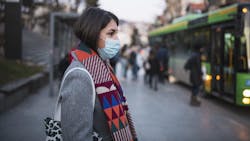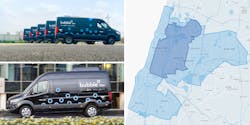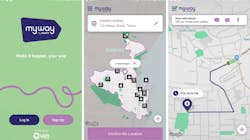Ten cities that have redefined public transportation during COVID-19
The importance of reliable public transportation may be easily overlooked by a majority of car-owning households, but as the COVID-19 pandemic forces many cities to significantly cut service, it’s been hard to ignore the void.
A disproportionately large number of essential service workers like grocery store employees, delivery people, first responders and healthcare workers still depend on access to public transportation to get to work during the global health crisis. However, steep declines in ridership leave some transit agencies no choice but to decrease service, with the U.S. government even allocating $25 billion in stimulus funding to help keep public transportation operational.
The critical need for transportation during the pandemic is why cities across the world have been adapting their transit services — or launching new ones — to address the rapidly changing needs of their communities. From changes that help essential employees get to work more easily (and often for free) to utilizing transit drivers and vehicles for delivery of vital goods, here are a number of cities have partnered with Via to make fast changes to help their communities during the pandemic.
Israel’s government shut down all public transportation in March in order to keep people safe, meaning travel options for those who still need to get to work — and who are working around the clock to treat the sick — became limited.
Tel Aviv’s Bubble Dan was swiftly repurposed as a transportation engine for essential healthcare workers, expanding the service zone from three cities to six in just two days. The move was strategic, with the new zones covering eight additional hospitals, three of which are the largest medical centers in the region.
Within two weeks, COTA evaluated its fixed-route ridership and revamped their service to address lower ridership along certain routes. Headquartered in Columbus, COTA is using its surplus vehicles and drivers to serve critical locations like hospitals, grocery stores, food banks and other critical transportation using the city’s newly launched COTA Plus app.
The Berliner Verkehrsbetriebe (BVG) rapidly made changes to its on-demand public transportation network BerlKönig to more effectively focus its service on essential employees and to minimize person-to-person contact.
Within days, the zone was expanded to include access to 75 percent of all hospital beds in Berlin, providing free transportation to essential healthcare workers. It also altered the hours of operation to better align with medical shifts and capped all vehicles at 50 percent capacity.
With the spread of COVID-19, Go-Coach accelerated its launch date of its new on-demand public transportation project Go2 by two months in order to address growing transportation needs during the crisis. It quickly adjusted its service plans to limit transportation to essential trips in a first-and-last mile model (addressing gaps in transit networks in the area), adjusting the original service zone to include four nearby hospitals and temporarily replacing a fixed-route bus system with on-demand service that both reduced costs and serviced essential rides.
In six days, ITC and United Trans launched a new on-demand microtransit service called the Abu Dhabi Healthcare Link to provide transportation to healthcare professionals. The service covers 36 local hospitals and clinics, offering door-to-door on-demand free rides to and from the local healthcare facilities. The ITC started the service with just 10 vehicles, but after seeing explosive demand within just hours of launching, it increased the size of the fleet by 50 percent within a few days.
The Cool on-demand public transportation service covered a small service zone in Malta before COVID-19 started spreading rapidly across the country. In response, Cool leaders started talking to drivers and customers to find out what the community needed most, and how their team could help.
As a result, within two days, Cool expanded its service to the entire island, and adjusted service to provide riders with private rides to properly account for social distancing. In addition, Cool now allows grocery stores and small businesses to deliver goods through the app, pooling multiple deliveries into the same vehicle to increase efficiencies, and providing drivers with the ability to distinguish between deliveries and passenger rides.
On the northeast coast of the United States, one Ivy League university replaced its existing fixed-route shuttle service for students with an on-demand, extended-hour service, providing riders with a safe mobility option for essential needs. In one day, the University was able to reduce vehicle capacity to 50 percent to allow for social distancing, making students and university community members feel safer as they travel to essential services.
In the face of COVID-19, the transit authority in Canterbury, New Zealand, accelerated the launch of its MyWay service in Timaru by a month. The authority thought through current transit needs and made the decision to limit the new service to transportation for essential services like medical appointments, grocery store runs and pharmacy pickups. MyWay completely replaced Timaru’s fixed-route bus system, introducing an on-demand service with reduced vehicle capacities to allow for social distancing and public health recommendations.
In Los Angeles, Calif., Los Angeles County Metropolitan Transportation Authority responded to ever-changing needs due to the coronavirus by expanding its three existing zones to include medical centers, grocery stores and pharmacies. Within one week, the service was providing trips anywhere within the zone (not just to its original first-and-last mile pickup and drop-off points at train stations). It swiftly shifted its service to accommodate social distancing measures by offering exclusively private rides, providing riders with a safe mobility option for essential needs.
In Washington State, Ben Franklin Transit partnered with Via to launch an on-demand transit service in West Pasco, starting with support for essential travel needs during the COVID-19 pandemic. The service was originally scheduled to launch in early April as a first-and-last-mile service that would extend access to affordable, efficient and convenient public transit, and has been rapidly transformed to support residents and essential workers during the health crisis. There are plans to expand the service to cover additional zones by May 11.
Under normal operations, the service will serve major bus stops and transit centers. However, during ongoing emergency response in the community, select essential service locations, including pharmacies, grocery stores and health clinics, have been added to ensure efficient access to these critical services.
----------------------------------------------------
About the Author

Frances Cooperman
Frances Cooperman is the Chief Marketing Officer at Via, the global leader in providing digital infrastructure to power public mobility in cities around the world. Prior to joining the team at Via, Frances held positions as the EVP of Marketing and Communications at Dataminr, Inc., as well as the Global Head of Marketing at Bloomberg. Frances earned a Bachelor of Arts from Brown University and a Master of Business Administration from Yale.











